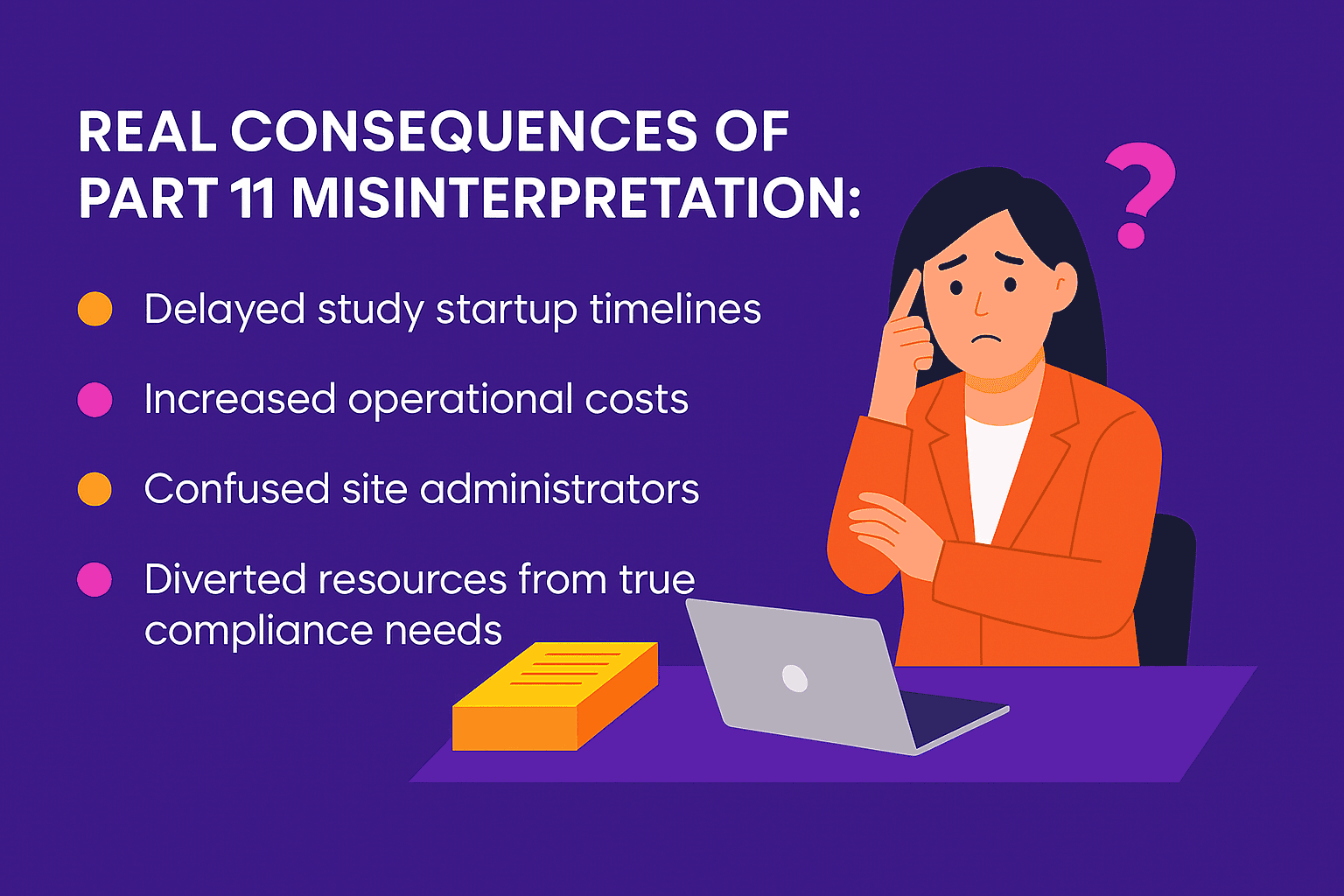Blog
April 24, 2025
The Contract NetworkMyth vs. Reality: Why Part 11 Doesn’t Apply to Your Clinical Research Agreements
As clinical trial processes evolve and regulatory environments become more complex, organizations that focus on appropriate compliance without unnecessary hurdles will have an advantage.
Key Takeaways
The Myth: FDA Requires Part 11 Compliance for E-Signed Clinical Trial Agreements
“Sorry, we can’t accept this electronically signed CTA without Part 11 validation…”
If you’ve heard this statement during study startup, you’re not alone. While the clinical trial community already faces countless challenges getting studies off the ground, misinterpreted regulations shouldn’t be one of them.
Let’s tackle a specific point of confusion that’s causing needless delays: the mistaken belief that 21 CFR Part 11 compliance is required to electronically sign clinical research agreements
The Reality: Part 11 Was Never Intended for these Contracts–and Still Isn’t
Simply put: Part 11 generally does not apply here.
Part 11 is essential, but its scope is narrow. It governs electronic records and signatures created or maintained to meet FDA predicate rules—think eCRFs, manufacturing logs, or lab data used to demonstrate product safety and efficacy.
WHAT PART 11 ACTUALLY COVERS:
Electronic records that directly support product approval, safety monitoring, and quality systems—not legal contracts between parties.
Clinical research agreements (CTAs, CDAs, DUAs, etc.) are vital legal contracts, but they are not the type of regulated records that Part 11 was designed to cover.
Make no mistake: FDA reviewers evaluate drug safety based on clinical data integrity—not by auditing the e-signature compliance of your clinical research agreements.
The Actual Requirements for CTAs and Related Agreements
The legal enforceability of e-signatures on these agreements comes from well-established laws:
| Law | Key Requirements | Example Platform Compliance |
|---|---|---|
| Federal ESIGN Act | • Consent to electronic signatures • Intent to sign • Attribution to signer • Record retention |
Most commercial e-signature platforms meet these standards without specialized validation |
| UETA | • Ability to reproduce records • Authentication of signers • Record integrity |
Standard platforms include audit trails and authentication sufficient for these purposes |
Standard platforms like Docusign and Adobe Acrobat Sign already fulfill these requirements for contracts. They don’t need the technical controls required under Part 11.
The Growing Confusion
A small but growing number of sponsors and CROs have started requesting Part 11 compliance for clinical trial agreements.
While regulatory caution is understandable, this demand misinterprets Part 11’s scope and creates unnecessary friction. The FDA’s attention, both in guidance and enforcement, remains focused on systems managing critical quality or clinical data—not routine contract execution tools.

Most concerning of all: imposing unnecessary Part 11 requirements distracts attention from systems that truly require robust Part 11 compliance: eCRFs, eCOA, eConsent, and similar systems supporting regulated data.
How to Stay Compliant—Without Creating Bottlenecks
The compliant and efficient path is simple:
- Use a reputable e-signature platform that adheres to ESIGN/UETA standards
- Implement standard security measures (e.g., multi-factor authentication)
- Archive signed agreements securely in your document management system
Direct your Part 11 efforts where they’re legally required and provide the greatest value: safeguarding the integrity of data that supports regulatory decisions. For clinical agreements, stick with proven e-signature laws.
Take Action This Week
- Review your current e-signature policies for clinical agreements.
- Schedule a 15-minute meeting with compliance, legal, and clinical operations.
- Share this article to start the conversation about aligning on the actual regulatory scope.
Addressing this misconception could significantly accelerate your study startup timelines without compromising compliance or quality.
Interested in learning about solutions that can help you accelerate your startup timelines? Contact us for tools that keep you compliant—without slowing you down.